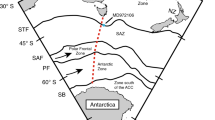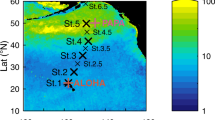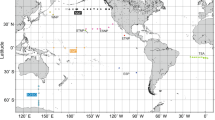Abstract
Decomposition of organic matter changes the concentrations of carbon, nitrogen, phosphorus, oxygen and titration alkalinity (TA) in the ratio 106:16:1:138:–17 (refs 1–3), so the combined effect of decomposing x mol of CaCO3 and y mol of organic matter in 1 kg of seawater on the preformed total CO2 (ΣCO20), preformed TA (TA0), biogenerated ΣCO2 [ΔΣCO2(biol)] and the apparent oxygen utilisation (AOU) can be represented as4 ΔΣCO2=ΣCO2(measured)−ΣCO20=x+106y ΔTA=TA(measured)−TA0=2x−17y ΔΣCO2(biol)=106y; AOU=138y Eliminating x and y from the above equations yields 
 Several early workers5–8 have successfully correlated ΔΣCO2(biol) to AOU with slopes close to the Redfield, Ketchum and Richards (RKR) model1. However, the methods used often have not satisfactorily taken into account the variation of the preformed values for ΣCO2 and TA with sample depth or have mistakenly taken ΔΣCO2(biol) to be equal to ΔΣCO2−O.5ΔTA. The inconsistency between the correlations above and below the thermocline is also not well explained. A modified computational scheme5,8 has recently been developed for calculating the ΣCO2-TA-oxygen correlation with the depth dependent variations of ΣCO20 and TA0 accounted for. The method of calculating ΔΣCO2 is the same as that described in ref. 4 but further useful information has been obtained by plotting ΔΣCO2 against AOU, rather than depth. The results in the Pacific Ocean, presented here, suggest a linear correlation between the bio-generated CO2 and AOU with a slope of 0.722±0.05, in good agreement with that predicted from the RKR model. The deviation of the data from this linear correlation for shallow water can largely be explained by the influences of human induced CO2.
Several early workers5–8 have successfully correlated ΔΣCO2(biol) to AOU with slopes close to the Redfield, Ketchum and Richards (RKR) model1. However, the methods used often have not satisfactorily taken into account the variation of the preformed values for ΣCO2 and TA with sample depth or have mistakenly taken ΔΣCO2(biol) to be equal to ΔΣCO2−O.5ΔTA. The inconsistency between the correlations above and below the thermocline is also not well explained. A modified computational scheme5,8 has recently been developed for calculating the ΣCO2-TA-oxygen correlation with the depth dependent variations of ΣCO20 and TA0 accounted for. The method of calculating ΔΣCO2 is the same as that described in ref. 4 but further useful information has been obtained by plotting ΔΣCO2 against AOU, rather than depth. The results in the Pacific Ocean, presented here, suggest a linear correlation between the bio-generated CO2 and AOU with a slope of 0.722±0.05, in good agreement with that predicted from the RKR model. The deviation of the data from this linear correlation for shallow water can largely be explained by the influences of human induced CO2.
This is a preview of subscription content, access via your institution
Access options
Subscribe to this journal
Receive 51 print issues and online access
$199.00 per year
only $3.90 per issue
Buy this article
- Purchase on Springer Link
- Instant access to full article PDF
Prices may be subject to local taxes which are calculated during checkout
Similar content being viewed by others
References
Redfield, A. C., Ketchum, B. H. & Richards, G. A. in The Sea Vol. 2 (ed. Hill, M. H.) 26–77 (Interscience, New York, 1963).
Brewer, P. G., Wong, G. T. F., Bacon, M. P. & Spencer, D. W. Earth, planet. Sci Lett. 26, 81–87 (1975).
Chen, C. T. Science 201, 735–736 (1978).
Chen, C. T. & Millero, F. J. Nature 277, 205–206 (1979).
Culberson, C. & Pytkowicz, R. M. J. Oceanogr. Soc. Jap. 26, 95–100 (1970).
Ben-Yaakov, S. J. geophys. Res. 76, 7414–7431 (1971); Mar. Chem. 1, 3–26 (1972).
Alvarez-Borrego, S. & Park, P. K. J. Oceanogr. Soc. Jap. 29, 193–202 (1973).
Edmond, J. M. Deep-Sea Res. 21, 455–480 (1974).
Ribbat, B. thesis Univ. Heidelberg (1975).
Revelle, R. & Suess, H. E. Tellus 9, 18–27 (1957).
Craig, H. Tellus 9, 1–17 (1957).
Bray, J. R. Tellus 11, 220–230 (1959).
Bolin, B. & Erikson, E. in The Atmosphere and the Sea in Motion (ed. Bolin, B.) 130–142 (Rockefeller, New York, 1959).
Broecker, W. S., Li, Y. H. & Peng, T. H. in Impingement of Man on the Oceans (ed. Hood, D. W.) 287–324 (Wiley, New York, 1971).
Keeling, C. D. Tellus 25, 174–198 (1973).
Woodwell, G. M. et al. Science 199, 141–146 (1978).
Stuiver, M. Science 199, 253–258 (1978).
Wong, C. S. Science 200, 197–200 (1978).
Postma, H. Nether, J. Res. 2, 258–283 (1964).
Brewer, P. G. Geophy. Res. Lett. 5, 997–1000 (1978).
Takahashi, T., Broecker, W. S., Prince, L. A. & Bainbridge, A. E. Earth planet. Sci. Lett. (submitted).
Ostlund, H. G., Brescher, R., Oleson, R. & Ferguson, M. J. Tritium Laboratory Data Report 8, (University of Miami, 1979).
Riley, G. A. Adv. mar. Biol. 8, 1–118 (1970).
Gordon, D. C. Deep-Sea Res. 18, 1127–1134 (1971).
Parsons, T. & Takahashi, M. Biological Oceanographic Processes (Pergamon, New York, 1973).
Gieskes, J. M. in The Sea, Vol. 5 (ed. Goldberg, E. D.) 123–151 (Interscience, New York, 1974).
Pytkowicz, R. M. Deep-Sea Res. 11, 381–389 (1964).
Oeschger, H., Siegenthaler, U., Schotterer, U. & Gugelmann, A. Tellus 27, 168–192 (1975).
Broecker, W. S., Peng, T. H. & Stuiver, M. J. geophys. Res. 83, 6179–6186 (1978).
Author information
Authors and Affiliations
Rights and permissions
About this article
Cite this article
Chen, CT., Pytkowicz, R. On the total CO2–titration alkalinity–oxygen system in the Pacific Ocean. Nature 281, 362–365 (1979). https://doi.org/10.1038/281362a0
Received:
Accepted:
Published:
Issue Date:
DOI: https://doi.org/10.1038/281362a0
This article is cited by
-
Monitoring Sediment and Water Chemistry in Small Remote Aquatic Systems in East Sepik Province, Papua New Guinea
Water, Air, & Soil Pollution (2021)
-
Control factors of DIC in the Y3 seamount waters of the Western Pacific Ocean
Journal of Oceanology and Limnology (2020)
-
Roles of Biogeochemical Processes in the Oceanic Carbon Cycle Described with a Simple Coupled Physical-Biogeochemical Model
Journal of Oceanography (2005)
-
Anthropogenic CO2 distribution in the North Pacific Ocean
Journal of Oceanography (1993)
Comments
By submitting a comment you agree to abide by our Terms and Community Guidelines. If you find something abusive or that does not comply with our terms or guidelines please flag it as inappropriate.



